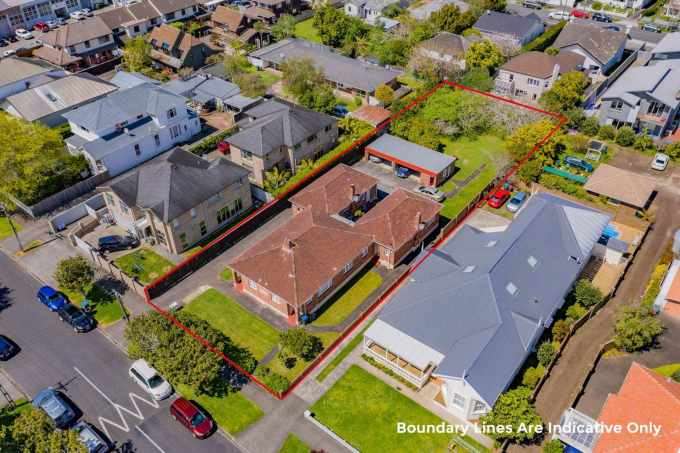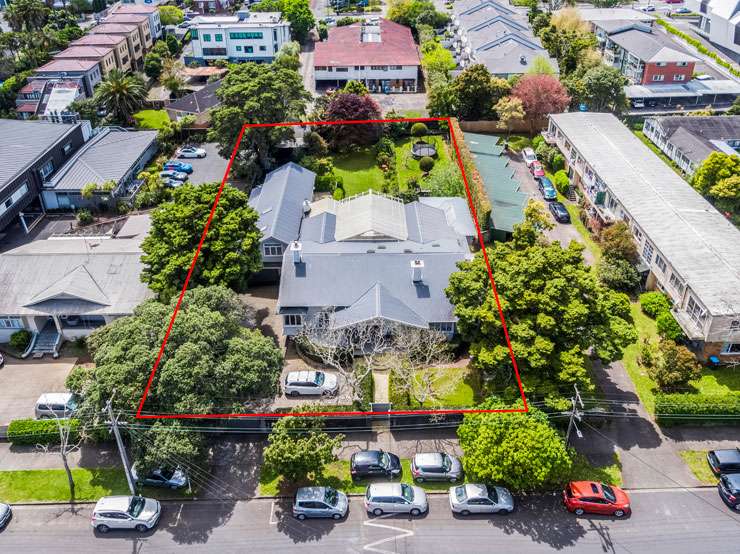Boundary lines on listing photos are contributing a lot to Auckland’s heated housing market. They are a red flag to developers, a sign that a property could sell well above vendor or buyer expectations.
Rarely seen on for sale signs a year ago, these thick red, yellow or white lines have become a permanent part of the Auckland market, as vendors and agents lean into the development possibilities afforded by the Auckland Unitary Plan.
READ MORE: Find out if your suburb is rising or falling
Properties zoned for townhouses or apartments are in demand, and the big sums developers are willing to pay for them can leave first home buyers frustrated.
Start your property search
Ray White Manukau owner Tom Rawson says cashed-up buyers have been targeting properties in South Auckland that have development potential. Most families and first home buyers in his patch won’t go near a house if they see a thick line around the property on the listing photos or sale sign.
“A family won’t even bother looking at a 1000sqm property in Manurewa because they know they’ll be beaten up by a developer.”
49 Gloucester, in Manurewa, is a prime example. The three-bedroom brick and tile house, which sits on a 890sqm site zoned Mixed Housing Urban, sold at the end of last year for $810,000, with the new owners settling in June. They decided to flick it on soon after, and, after listing it with Ray White agent Jay Singh, sold it under the hammer this month for $1.305 million.
The vendors walked away with $495,000 in just five months without doing any improvements.
Rawson said there were three developers bidding on the property and they were all prepared to pay a premium. “The owners didn’t want to do anything to it and if the property has gone up that much in value you might as well just sell it now and get out of it,” he said.

12 King Edward Avenue, in Epsom, sold for $7.06 million under the hammer. Photo / Supplied
Many of the Auckland properties billed as having development potential are ex state houses that are being rented out – a plus for developers who may need holding income while firming up their plans.
“Even if you’re getting $1000 a week from a property, that’s $50,000 a year and it’s costing you $25,000 a year on interest, so it’s actually a positive cash flow and developers hold on to it for a while they work on another property,” Rawson said.
Earlier this month, a tired brick and tile house in Auckland's prized double grammar zone sold under the hammer for $7.06 million - $2.36 million above its 2017 rating valuation.
The eight-bedroom house, which sits on 1373sqm of flat land at 12 King Edward Avenue, in Epsom, was snapped up by a developer after fierce competition at Barfoot and Thompson's auction rooms.
The rental property had been pitched as a developer's dream due to its lucrative Terrace Housing and Apartment zoning.
Barfoot and Thompson agents George Fong and Laura McAuley said the sale price was a surprise to both them and the vendor.
“I did not expect it to go this far, but in this market, you never know, especially when selling at an auction," Fong said.
All thirteen bidders at the auction were either developers or investors. The bidding started high at $4.5 million, and quickly shot passed the reserve. All in all 55 bids were made.
Some homes sporting the thick line, however, are more luxurious than others, and are suitable for first time buyers or families looking to upsize or relocate to a better suburb.
In Remuera, 6 MacMurray Road is a modern five-bedroom family home with a two-bedroom dwelling and self-contained office. The 1821sqm double grammar zone property is being advertised for sale by way of tender by Bayleys Commercial agents Alan Haydock and Damien Bullick.

6 MacMurray Road, in Remuera, has commercial and residential development potential. Photo / Supplied
Although an ideal home for a family, the property also benefits from a business zoning, and the agents say it holds exciting possibilities for future development.
“The zoning allows for a myriad of options, including apartments or terraced housing, and medical and commercial developments, for which this area is already in demand. Other permitted activities range from offices to retail, entertainment facilities or visitor accommodation,” Haydock said.
Bayleys One Tree Hill owner Glenn Baker said homes located on sites with potential for development were often listed on commercial and residential sites to widen the buyer's pool.
“The red line gives home buyers a lot of confidence in what they are paying as the property has other potential uses,” he said.
Baker said while owner-occupiers might be stretching their budgets to secure a property with a red line around it, such homes would retain their value and potential.
“In today’s market the buyers are paying a lot more than what they would a few months ago but when you a buying a development property, it’s justified because further down the track you could take advantage of the zoning,” Baker said.
James Wilson, director of valuation at OneRoof’s data partner Valocity, said the most sought-after zone in Auckland was mixed-housing urban zone.
“We see a lot of it through the southern corridor in Mount Wellington, Ellerslie, Pakuranga and Manukau,” he said.
Sellers and buyers had only woken up to the potential of unitary plan’s zoning in the last two years.
The idea behind the unitary plan was to add more density to established areas and support sustainable development, he said. “When it first came out people were working it out and it took a while for the market to understand what the zones allowed and what it meant for builders and developers.”











